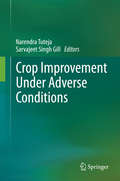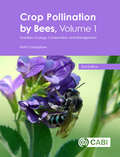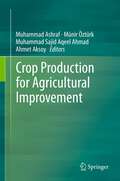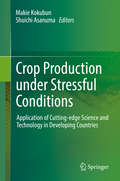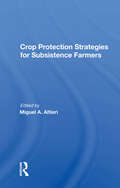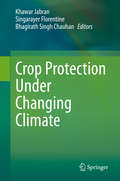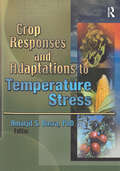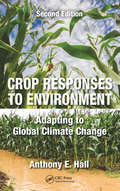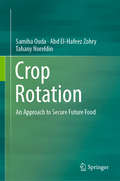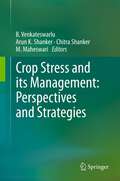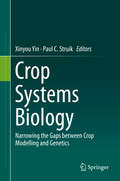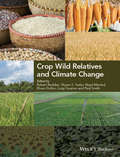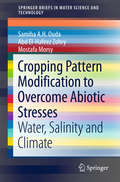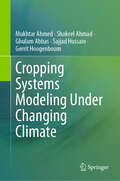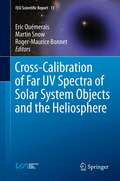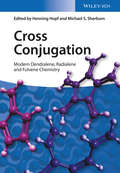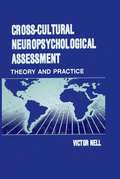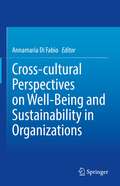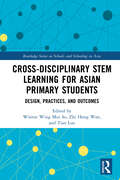- Table View
- List View
Crop Improvement Under Adverse Conditions
by Sarvajeet Singh Gill Narendra TutejaPlant development and productivity are negatively regulated by various environmental stresses. Abiotic stress factors such as heat, cold, drought, and salinity represent key elements limiting agricultural productivity worldwide. Thus, developing crop plants with the ability to tolerate abiotic stresses is a critical need which demands modern novel strategies for the thorough understanding of plant response to abiotic stresses. Crop Improvement under Adverse Conditions will serve as a cutting-edge resource for researchers and students alike who are studying plant abiotic stress tolerance and crop improvement. The book presents the latest trends and developments in the field, including the impact of extreme events on salt tolerant forest species of Andaman & Nicobar Islands, the overlapping horizons of salicylic acid in different stresses, and fast and reliable approaches to crop improvement through In Vitro haploid production. Written by renowned experts and featuring useful illustrations and photographs, Crop Improvement under Adverse Conditions is a concise and practical update on plant abiotic stress tolerance and crop improvement.
Crop Improvement Utilizing Biotechnology
by Rup LalThis book discusses; somaclonal variation in crop improvement, the role of tissue culture in rapid clonal propagation and production of pathogen-free plant, protoplasts in crop improvement, cell selection and long-term high-frequency regeneration of cereals and legumes, agrobacteria-mediated gene transformation and vectors for gene cloning in plants, and plant frost injury and its management.
Crop Plant Anatomy
by Dasari Rajkumar Ratikanta Maiti Pratik Satya Allam RamaswamyDivided into four sections covering anatomy in relation to crop management, anatomical descriptions of the major crop plants, anatomical changes in adaptation to environments and the link between anatomy and productivity, this book provides a comprehensive source of crop plant anatomy information. The crop areas covered include cereals, pulses and beans, oil crops and fibre crops. Suitable for students, researchers and professionals in the field, this book brings together economic plant anatomy and crop productivity for the first time.
Crop Pollination by Bees, Volume 1: Evolution, Ecology, Conservation, and Management
by Dr Keith DelaplaneSince the second half of the 20th Century, our agricultural bee pollinators have faced mounting threats from ecological disturbance and pan-global movement of pathogens and parasites. At the same time, the area of pollinator-dependent crops is increasing globally with no end in sight. Never before has so much been asked of our finite pool of bee pollinators. This book not only explores the evolutionary and ecologic bases of these dynamics, it translates this knowledge into practical research-based guidance for using bees to pollinate crops. It emphasizes conserving wild bee populations as well as culturing honey bees, bumble bees, and managed solitary bees. To cover such a range of biology, theory, and practice from the perspectives of both the pollinator and the crop, the book is divided into two volumes. Volume 1 focuses on bees, their biology, coevolution with plants, foraging ecology and management, and gives practical ways to increase bee abundance and pollinating performance on the farm. Volume 2 (also available from CABI) focuses on crops, with chapters addressing crop-specific requirements and bee pollination management recommendations. Both volumes will be essential reading for farmers, horticulturists and gardeners, researchers and professionals working in insect ecology and conservation, and students of entomology and crop protection.
Crop Pollination by Bees, Volume 2: Individual Crops and their Bees
by Dr Keith DelaplaneSince the second half of the 20th Century, our agricultural bee pollinators have faced mounting threats from ecological disturbance and pan-global movement of pathogens and parasites. At the same time, the area of pollinator-dependent crops is increasing globally with no end in sight. Never before has so much been asked of our finite pool of bee pollinators. This book not only explores the evolutionary and ecologic bases of these dynamics, it translates this knowledge into practical research-based guidance for using bees to pollinate crops. It emphasizes conserving wild bee populations as well as culturing honey bees, bumble bees, and managed solitary bees. To cover such a range of biology, theory, and practice from the perspectives of both the pollinator and the crop, the book is divided into two volumes. Volume 1 focuses on bees, their biology, coevolution with flowering plants, foraging ecology and management, and gives practical ways to increase bee abundance and pollinating performance on the farm. Volume 2 (this volume) focuses on crops, with chapters addressing crop-specific requirements and bee pollination management recommendations. Both volumes are essential reading for farmers, horticulturists and gardeners, researchers and professionals working in insect ecology and conservation, and students of entomology and crop protection.
Crop Production for Agricultural Improvement
by Münir Öztürk Muhammad Ashraf Ahmet Aksoy Muhammad Sajid AhmadIn the recent years, the looming food scarcity problem has highlighted plant sciences as an emerging discipline committed to devise new strategies for enhanced crop productivity. The major factors causing food scarcity are biotic and abiotic stresses such as plant pathogens, salinity, drought, flooding, nutrient deficiency or toxicity which substantially limit crop productivity world-wide. In this scenario, strategies should be adopted to achieve maximum productivity and economic crop returns. In this book we have mainly focused on physiological, biochemical, molecular and genetic bases of crop development and related approaches that can be used for crop improvement under environmental adversaries. In addition, the adverse effects of different biotic (diseases, pathogens etc.) and abiotic (salinity, drought, high temperatures, metals etc) stresses on crop development and the potential strategies to enhance crop productivity under stressful environments are also discussed.
Crop Production under Stressful Conditions: Application of Cutting-edge Science and Technology in Developing Countries
by Shuichi Asanuma Makie KokubunThis book presents field studies on crop production in developing countries such as Vietnam, Kenya, Namibia, Colombia, Afghanistan and Sudan. Further, it examines the achievements of SATREPS, a development assistance program sponsored by the Japanese government that promotes international joint research to address these global issues. In this context, multidisciplinary research teams consisting of breeders, physiologists, soil scientists, agronomists, and other scientists related to agricultural development worked together to tackle the challenges involved in enhancing the capacity of crop production in the respective regions. In addition to presenting novel scientific findings, this book highlights practical field studies that verify the effectiveness of the scientific findings in actual environments. The achievements will help to improve crop production worldwide, and the lessons learnt will be useful in re-designing strategies to address global issues in crop production, particularly in developing regions. Lastly, the outcomes discussed will be useful to policymakers and professionals engaged in crop production and food security in developing countries, as well as researchers and students.
Crop Protection Strategies For Subsistence Farmers
by Miguel A AltieriTop-down approaches to pest management, relying on agrochemical inputs that can be scarce, expensive, ecologically toxic, or inaccessible, have repeatedly failed to solve pest problems that affect small farmers in developing countries. Crop Protection Strategies for Subsistence Farmers offers an alternative. Drawing on examples from Latin Am
Crop Protection Under Changing Climate
by Khawar Jabran Singarayer Florentine Bhagirath Singh ChauhanThis book addresses the impact of important climatic changes on plant pests (including weeds, diseases and insect pests), and their interactions with crop plants. Anthropogenic activities have seriously impacted the global climate. As a result, carbon dioxide (CO2) and temperature levels of the earth are on a continuous rise. The global temperature is expected to increase by a 3°C or more by the end of this century. The CO2 concentration was below 300 parts per million (ppm) before the start of the industrial era; however, recently it has exceeded 400 ppm. This is highest ever in human history. Other than global warming and elevated CO2 concentrations, anthropogenic activities have also disturbed the global water cycle, ultimately, impacting the quantity and distribution of rainfall. This has resulted in drought conditions in many parts of the world. Global warming, elevated CO2 concentration and drought are considered the most important recent climatic changes that are impacting global ecosystems and human societies. Among other impacts, the effects of climatic changes on pests, pest-crop interactions and pest control are important with relevance to global food security, and hence require immediate attention by plant scientists. This book discusses innovative and the most effective pest control methods under an environment of changing climate and elaborates on the impact of drought on plant pests and their control.
Crop Responses and Adaptations to Temperature Stress: New Insights and Approaches
by Amarjit S. BasraExamine the ways in which various plants respond when exposed to high and low temperatures!The growing demand for food makes breeding for high-yielding crops with built-in resistance against environmental constraints one of the most important challenges for plant breeders today. Crop Responses and Adaptations to Temperature Stress investigates the adaptive mechanisms plants have evolved in response to unfavorable temperature conditions. It describes gene transfer technology and other tolerance improvement techniques that aid in developing stress-tolerant plants.Adverse environmental stress conditions, such as extreme temperatures, affect the productivity of important world food crops by inhibiting plant growth and development. Crop Responses and Adaptations to Temperature Stress provides valuable information on the mechanisms of stress tolerance in plants that encourage growth and enhance yield performance.Agriculture professionals, researchers, and plant breeders will benefit from the ideas shared on such topics as: mechanisms of chilling injury and tolerance injury and acclimation of root system functions during chilling temperatures mechanisms of cold acclimation signal transduction under low-temperature stress mechanisms of thermotolerance in crops control of the heat shock response in crop plants the effects of heat stress on cereal yield and qualityCrop Responses and Adaptations to Temperature Stress presents detailed discussions on the effects and outcomes of crop exposure to low and high temperatures. The textual information is liberally supplemented with visual representations of field experiment data as well as comprehensive tables and schematic drawings.In addition to a detailed review of current knowledge on the molecular biology of plant responses to temperature stress and an introduction to biotechnological advances in improving crop tolerance, Crop Responses and Adaptations to Temperature Stress suggests avenues for further study and speculates on the implications of such work for the future of food production.
Crop Responses to Environment: Adapting to Global Climate Change, Second Edition
by Anthony E. HallFollowing in the tradition of its predecessor, Crop Responses to Environment, this fully updated and more comprehensive second edition describes aspects of crop responses to environment that are particularly relevant to the development of improved crop cultivars and management methods on a global scale. It includes an extensive discussion of the difficulties in developing agricultural systems that accommodate increasing human needs for agricultural products during the twenty-first century in a sustainable manner. The book features new sections on adaptation to global climate change including adapting to global warming, elevated atmospheric carbon dioxide concentration, and increased flooding and salinity through plant breeding and changes in crop management. Warming effects include stressful effects of heat on pollen development and reduced winter chilling effects on fruit and nut trees. The book examines principles, theories, mathematical models, and experimental observations concerning plant responses to environment that are relevant to the development of improved crop cultivars and management methods. It illustrates the importance of considering emergent plant properties as well as reductionist approaches to understanding plant function and adaptation. Plant physiological and developmental responses to light and temperature, and plant water relations are considered in detail. Dr. Hall also describes climatic zone definitions based on temperature, rainfall, and evaporative demand in relation to plant adaptation and the prediction of crop water use. Irrigation management and crop responses to salinity, flooding and toxic levels of boron and aluminum are considered. Crop responses to pests and diseases as they interact with crop responses to physical and chemical aspects of the environment are examined. The book concludes with analyses illustrating the relevance of crop responses to environment to plant breeding.
Crop Rotation: An Approach to Secure Future Food
by Tahany Noreldin Abd El-Hafeez Zohry Samiha OudaThis book tackles the issue of using crop rotation to increase food production and secure it for the growing population of the future. Crop rotation can be a solution of food gaps in the developing counties. Crop rotation plays an important role in attaining soil sustainability and in controlling pests and weeds. It can alleviate damage caused by climate change by reducing losses in productivity of the crops, minimizing soil fertility loss and increase irrigation water productivity. This book also includes the reviews of a large number of crop rotations that have been published internationally, and additionally, the crop rotations that have been implemented in Egypt have a unique characteristic to them and therefore, a large number of those reviews have also been included.
Crop Stress and its Management: Perspectives And Strategies
by Chitra Shanker B. Venkateswarlu Arun K. Shanker M. MaheswariCrops experience an assortment of environmental stresses which include abiotic viz., drought, water logging, salinity, extremes of temperature, high variability in radiation, subtle but perceptible changes in atmospheric gases and biotic viz., insects, birds, other pests, weeds, pathogens (viruses and other microbes). The ability to tolerate or adapt and overwinter by effectively countering these stresses is a very multifaceted phenomenon. In addition, the inability to do so which renders the crops susceptible is again the result of various exogenous and endogenous interactions in the ecosystem. Both biotic and abiotic stresses occur at various stages of plant development and frequently more than one stress concurrently affects the crop. Stresses result in both universal and definite effects on plant growth and development. One of the imposing tasks for the crop researchers globally is to distinguish and to diminish effects of these stress factors on the performance of crop plants, especially with respect to yield and quality of harvested products. This is of special significance in view of the impending climate change, with complex consequences for economically profitable and ecologically and environmentally sound global agriculture. The challenge at the hands of the crop scientist in such a scenario is to promote a competitive and multifunctional agriculture, leading to the production of highly nourishing, healthy and secure food and animal feed as well as raw materials for a wide variety of industrial applications. In order to successfully meet this challenge researchers have to understand the various aspects of these stresses in view of the current development from molecules to ecosystems. The book will focus on broad research areas in relation to these stresses which are in the forefront in contemporary crop stress research.
Crop Systems Biology: Narrowing the gaps between crop modelling and genetics
by Xinyou Yin Paul C. StruikThe sequencing of genomes has been completed for an increasing number of crop species, and researchers have now succeeded in isolating and characterising many important QTLs/genes. High expectations from genomics, however, are waving back toward the recognition that crop physiology is also important for realistic improvement of crop productivity. Complex processes and networks along various hierarchical levels of crop growth and development can be thoroughly understood with the help of their mathematical description - modelling. The further practical application of these understandings also requires quantitative predictions. In order to better support design, engineering and breeding for new crops and cultivars for improving agricultural production under global warming and climate change, there is an increasing call for an interdisciplinary research approach, which combines modern genetics and genomics, traditional physiology and biochemistry, and advanced bioinformatics and modelling. Such an interdisciplinary approach has been practised in various research groups for many years. However, it does not seem to be fully covered in the format of book publications. We want to initiate a book project on crop systems biology - narrowing the gaps between genotypes and phenotypes and the gaps between crop modelling and genetics/genomics, for publication in 2013/2014. The book will be meant for those scientists and graduate students from fundamental plant biology and applied crop science who are interested in bridging the gap between these two fields. We have invited a group of scientists (who have very good track records in publishing excellent papers in this field or in a closely related area) to contribute chapters to this new book, and they have agreed to do so.
Crop Wild Relatives and Climate Change
by Shyam Singh Yadav Luigi Guarino Mohammad Ehsan Dulloo Nigel Maxted Paul Smith Robert Reddeny genetic traits of wild relatives to crops are covered. There is also a valuable discussion on the importance of conserving genetic resources to ensure continued successful crop production. A timley resource, Crop Wild Relative and Climate Change will be an invaluable resource for the crop science community for years to come.
Cropping Pattern Modification to Overcome Abiotic Stresses: Water, Salinity and Climate (SpringerBriefs in Water Science and Technology)
by Abd El-Hafeez Zohry Samiha A. H. Ouda Mostafa MorsyThis book provides state-of-the art analysis, never done before in Egypt, on agro-climatic zones level. This study deals with how the national cropping pattern can be modified to overcome abiotic stresses, such as water scarcity, induced salinity and climate change to reduce their negative effects on food production. To this end, different cropping patterns are suggested. This study can be a framework for other developing countries to be used in quantifying and filling the gap in their knowledge about practices that can help in increasing their food security through increasing food production. Furthermore, the study is useful for policy makers to help them in their future plans and policies.
Cropping Systems Modeling Under Changing Climate
by Gerrit Hoogenboom Mukhtar Ahmed Ghulam Abbas Sajjad Hussain Shakeel AhmadThis book aims at bringing out comprehensive information on cropping systems modelling in the world. The major focus of this book is to address the integration of soil, plant and environmental interactions for climate smart agriculture. This book covers aspects of application of Decision Support System for Agrotechnology Transfer (DSSAT) for climate smart agriculture. Step-by-step details of application of modelling approaches used for various cropping systems under changing climate are provided which are being adopted by farmers in the world. The book is enriched with figures or diagrams to show the various mechanisms involved to support the decision making for climate change adaptations. Essential information is given regarding crop models calibration, evaluation and application and every individual chapter is comprised of a specific cropping system. Further contents include integration of climate models and crop models for refining the decisions for sustaining the production of various cropping systems for climate smart agriculture. This book assists the agricultural scientists involved in research regarding climate smart agriculture for improving the standards of agricultural research for ensuring food security under changing climate. This is also equally useful for policy makers being involved in future planning.
Crops Residue Management
by J. L. HatfieldRecent changes in the Conservation Compliance Plans for farmers shows the need for improved information on the effective management of crop residues. Residue management requires an understanding of the crop, soil, and climate in which the farming system is located. In this volume, the strategies for effective residue management are described for each region of the country to provide a comparison of the regional differences. The chapters not only describe the knowledge in each region but also suggest some of the needed areas of research required to develop an improved understanding of the processes involved in effective residue management.
Cross-Calibration of Far UV Spectra of Solar System Objects and the Heliosphere (ISSI Scientific Report Series #13)
by Roger-Maurice Bonnet Eric Quémerais Martin SnowThis book is the result of a working group sponsored by ISSI in Bern, which was initially created to study possible ways to calibrate a Far Ultraviolet (FUV) instrument after launch. In most cases, ultraviolet instruments are well calibrated on the ground, but unfortunately, optics and detectors in the FUV are very sensitive to contaminants and it is very challenging to prevent contamination before and during the test and launch sequences of a space mission. Therefore, ground calibrations need to be confirmed after launch and it is necessary to keep track of the temporal evolution of the sensitivity of the instrument during the mission. The studies presented here cover various fields of FUV spectroscopy, including a catalog of stellar spectra, datasets of Moon Irradiance, observations of comets and measurements of the interplanetary background. Detailed modelling of the interplanetary background is presented as well. This work also includes comparisons of older datasets with current ones. This raises the question of the consistency of the existing datasets. Previous experiments have been calibrated independently and comparison of the datasets may lead to inconsistencies. The authors have tried to check that possibility in the datasets and when relevant suggest a correction factor for the corresponding data.
Cross Conjugation: Modern Dendralene, Radialene and Fulvene Chemistry
by Henning Hopf Michael S. SherburnFilling a gap in the market, this handbook provides a comprehensive overview of the fascinating and expanding field of cross-conjugated molecules, their chemistry, synthesis and properties. The editor is one of the world's leading scientists in the field, and has assembled here a team of experts to discuss different classes of molecules, as well as the use of cross-conjugation for organic synthesis and applications in electronic systems and material science.
Cross, Constellation, and Crucible: Lutheran Theology and Alchemy in the Age of the Reformation
by John Warwick MontgomeryOriginally appearing in the Transactions of the Royal Society of Canada, 1963, this book follows the lead of Dr. John Warwick Montgomery, who traces the parallel paths of the two major paradigm shifts of the early modern era, the Copernican Revolution and the Protestant Reformation. Along the way, he delivers well-researched insights into the surprisingly close relationship between religion and science in both their day and ours.
Cross-Cultural Neuropsychological Assessment: Theory and Practice
by Victor NellThis is a book for all neuropsychologists who are called upon to assess culturally different clients--with very few exceptions today, this means every neuropsychologist. In Minneapolis as in Oslo, migrant and refugee minorities raise assessment and test validity problems that cannot be ignored. To deal realistically with the problem of doing neuropsychological assessments without norms, Nell describes the principles of a "behavioral neuropsychology," and then sets out interview, test, and interpretation methods that will allow clinicians to produce valid and prognostically accurate assessments. For working neuropsychologists, this is an intensely practical, how-to-do-it book. But unlike other hands-on guides, it lays an impressive historical and theoretical foundation for the practice of cross-cultural neuropsychology. It thus speaks to serious practitioners who need to be certain that their assessment findings are not only correct, but also sufficiently well-grounded to stand up to professional scrutiny and to forensic testing in a court of law.
Cross-cultural Perspectives on Well-Being and Sustainability in Organizations
by Annamaria Di FabioThis book explores a new area of psychology of sustainability and sustainable development with specific focus on organizations, and introduces a range of advanced perspectives for healthy business, harmonization and decent work. Split into two parts, the first half presents cross-cultural contributions that study in depth the benefits and drawbacks of sustainability, while the second half discusses theoretical approaches and empirical research that offer new prospects for innovation in prevention science. Gathering research from leading scholars and researchers from around the globe, this book offers an essential reference guide that will benefit researchers, professionals, students, and policy makers interested in promoting better business harmony and sustainability.
Cross-Cultural Scientific Exchanges in the Eastern Mediterranean, 1560–1660
by Avner Ben-ZakenAvner Ben-Zaken reconsiders the fundamental question of how early modern scientific thought traveled between Western and Eastern cultures in the age of the so-called Scientific Revolution. Through five meticulously researched case studies—in which he explores how a single obscure object or text moved in the Eastern world—Ben-Zaken reveals the intricate ways that scientific knowledge moved across cultures. His diligent exploration traces the eastward flow of post-Copernican cosmologies and scientific discoveries, showing how these ideas were disseminated, modified, and applied to local cultures.Never before has a student of scientific traffic in the Mediterranean taken such pains to see precisely which instruments, books, and ideas first appeared where, in whose hands, by what means, and with what implications. In doing so, Ben-Zaken challenges accepted views of Western primacy in this fruitful exchange. He shows not only how Islamic cultures benefited from European scientific knowledge but also how Eastern understanding of classical Greek texts informed developments in the West.Ben-Zaken’s mastery of different cultures and languages uniquely positions him to tell this intriguing story. His findings reshape our understanding of scientific discourse in this critical period and contribute to the growing field of cross-cultural Christian-Muslim studies.
Cross-disciplinary STEM Learning for Asian Primary Students: Design, Practices, and Outcomes (Routledge Series on Schools and Schooling in Asia)
by So, Winnie Wing Mui Zhi Hong Wan Tian LuoGiven the importance of student learning in the various types and integration of STEM education, this book provides a landscape of cross-disciplinary STEM learning in Asian primary schools, and a systematic overview of design, practices, and outcomes of STEM learning implementation. Science, Technology, Engineering and Mathematics (STEM) has continued to attract attention worldwide, and there have been calls for the promotion of STEM education in primary schools to nurture students to meet the needs of societies in terms of innovation and technology development. Since STEM is complex in nature and is related to various disciplines, the effort of a single discipline may not be as effective as cross-disciplinary efforts. This edited volume, involving an Asian team of authors, examines how cross-disciplinary STEM learning can be designed for students to achieve viable outcomes, and what opportunities and challenges have been offered to the next generation to equip them with the necessary skills, knowledge, and ways of thinking, as well as attitudes and values for lifelong learning. A resourceful text for students, researchers, and practitioners interested in the rich development of STEM education and practical methods for a variety of learning approaches from elementary to secondary education has been provided.
